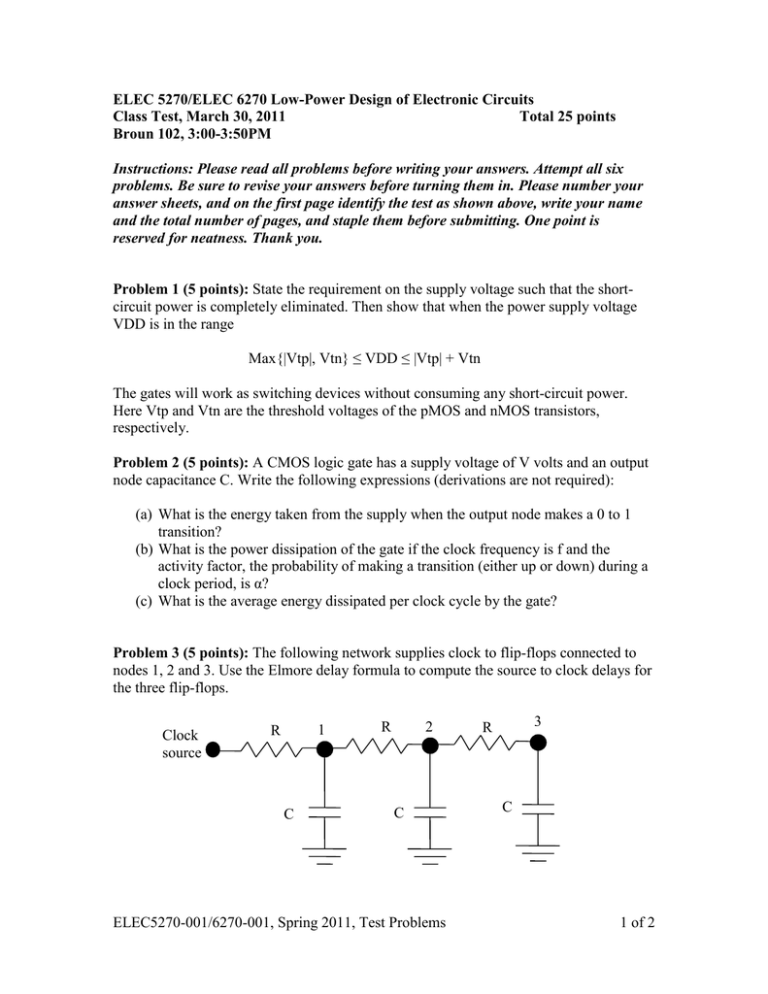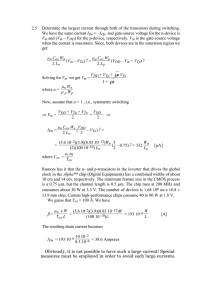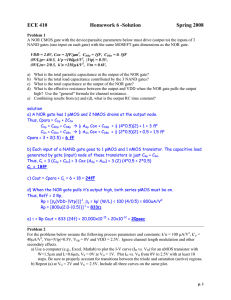ELEC 5270/ELEC 6270 Low-Power Design of Electronic Circuits Total 25 points
advertisement

ELEC 5270/ELEC 6270 Low-Power Design of Electronic Circuits
Class Test, March 30, 2011
Total 25 points
Broun 102, 3:00-3:50PM
Instructions: Please read all problems before writing your answers. Attempt all six
problems. Be sure to revise your answers before turning them in. Please number your
answer sheets, and on the first page identify the test as shown above, write your name
and the total number of pages, and staple them before submitting. One point is
reserved for neatness. Thank you.
Problem 1 (5 points): State the requirement on the supply voltage such that the shortcircuit power is completely eliminated. Then show that when the power supply voltage
VDD is in the range
Max{|Vtp|, Vtn} ≤ VDD ≤ |Vtp| + Vtn
The gates will work as switching devices without consuming any short-circuit power.
Here Vtp and Vtn are the threshold voltages of the pMOS and nMOS transistors,
respectively.
Problem 2 (5 points): A CMOS logic gate has a supply voltage of V volts and an output
node capacitance C. Write the following expressions (derivations are not required):
(a) What is the energy taken from the supply when the output node makes a 0 to 1
transition?
(b) What is the power dissipation of the gate if the clock frequency is f and the
activity factor, the probability of making a transition (either up or down) during a
clock period, is α?
(c) What is the average energy dissipated per clock cycle by the gate?
Problem 3 (5 points): The following network supplies clock to flip-flops connected to
nodes 1, 2 and 3. Use the Elmore delay formula to compute the source to clock delays for
the three flip-flops.
Clock
source
1
R
C
R
2
C
ELEC5270-001/6270-001, Spring 2011, Test Problems
3
R
C
1 of 2
Problem 4 (5 points): A combinational circuit is tested by a set of five vectors. The test
system initializes to the first vector 1111, which should be retained as the starting vector.
Remaining vectors can be arbitrarily sequenced. Find the minimum energy test sequence.
How much does your sequence save over the original sequence? The given test vector
sequence is:
Vector number
1
1
1
1
1
2
0
0
0
0
3
1
0
0
0
4
0
1
1
0
5
1
0
0
1
Problem 5 (5 points): Consider the multiplexer circuit in the following schematic. The
numbers in gates and buffers show their delays in time units. The input changes shown
occur simultaneously. If each gate or buffer consumes 1 unit of dynamic energy per
transition at its output then determine the total dynamic energy dissipation for the given
input signals. Prove that the number of transitions at the primary output cannot exceed
four for any set of hazard-free primary input transitions caused by an input vector-pair.
11
1
10
3
1
1
2
11
7
Problem 6 (1 point bonus question): Consider an automobile that consumes idling
power of 10,000 watts. This power is consumed as long as the engine is turned on and is
not affected by the speed of the car. In addition, the car consumes dynamic power given
by 4v2 watts, where v is the speed in miles per hour. Assuming only freeway driving (no
idling stops) find the most economical speed at which the car will consume the least
energy. What are the proportions of the idling and dynamic energies under the optimum
condition?
ELEC5270-001/6270-001, Spring 2011, Test Problems
2 of 2





